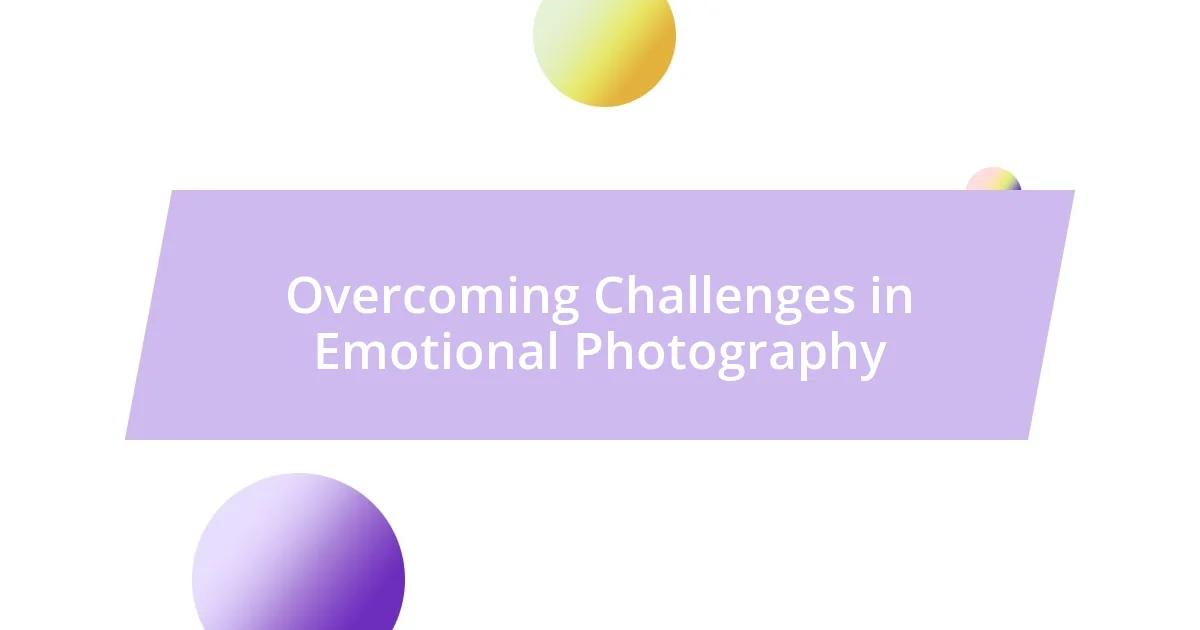Key takeaways:
- Emotions deeply influence our connections and experiences, serving as a foundation for understanding ourselves and others.
- Authentic emotional capture in photography requires vulnerability, patience, and building genuine connections with subjects.
- Editing plays a crucial role in enhancing the emotional impact of images, transforming ordinary moments into resonant stories.

Understanding the Essence of Emotions
Emotions are like a rich tapestry woven from our experiences, thoughts, and beliefs. I remember a time when I felt overwhelmed with joy after receiving unexpected news about a loved one. That moment made me realize how emotions can profoundly shape our lives, creating connections that sometimes defy explanation.
Have you ever noticed how even the simplest moments can stir deep feelings? For instance, watching a child’s first steps brought an unexpected wave of nostalgia and pride not just for that child, but for the parents and the entire journey they embarked on together. This is the essence of emotions—they connect us to our past, present, and future in ways that words alone often fail to capture.
Understanding emotions means diving underneath the surface to explore what truly drives them. In my experience, embracing vulnerability was crucial; moments of sadness and joy often danced side by side, revealing a beautiful complexity that’s easy to overlook. What if we allowed ourselves to sit with our feelings, pondering their origins and meanings? That’s where the real understanding begins.

Discovering My Passion for Photography
My passion for photography ignited during a spontaneous trip to the mountains. Standing amidst the towering pines, I felt overwhelmed by the beauty surrounding me. In that moment, I instinctively reached for my camera, wanting to capture not just the scenery, but the feelings it stirred within me.
As I started snapping pictures, I noticed how each click immortalized a fleeting emotion. One photo, in particular, captured a radiant sunrise breaking through the clouds. When I looked at it, I felt the hope and renewal that morning symbolized; it was like my heart was speaking through the lens. This realization made me appreciate photography as a powerful tool for storytelling—one that allows me to translate emotions into visuals.
In my journey, I’ve learned that photography is more than just an art form; it’s a way of connecting with others. During a family gathering, I began taking candid shots of everyone interacting, and the smiles and laughter I captured showed a depth of joy I hadn’t noticed in the moment. It dawned on me that these photographs were not merely images, but priceless memories filled with raw emotion, reinforcing my passion for this craft.
| Aspect | Details |
|---|---|
| Initial Moment | Spontaneous trip to the mountains igniting my passion |
| Emotional Capture | Photographs translating feelings, such as hope from a sunrise |
| Connection with Others | Candid shots at a family gathering revealing deeper joys |

Techniques for Authentic Emotional Capture
Embracing authenticity is key to capturing real emotions in photography. I find that being present in the moment truly matters. For instance, during a quiet walk in my neighborhood, I stumbled upon an elderly couple sharing a laugh on a park bench. Rather than rushing to grab my camera, I paused, letting their joy envelop me. It was in that stillness that I felt a genuine connection, allowing me to approach them naturally. The result? A photograph that radiated warmth and love without any forced poses.
Here are some techniques that have shaped my approach to authentic emotional capture:
- Be Vulnerable: Allow yourself to feel the emotions of the moment. It opens up pathways for genuine expression.
- Inclusive Environment: Surround yourself with people you trust; it helps everyone relax, making it easier to elicit natural emotions.
- Stay Patient: Sometimes the best moments come when you give it time, rather than setting an agenda.
- Storytelling: Focus on conveying a story through your images. Each element in a photograph can contribute to a larger emotional narrative.
- Engage with Subjects: Building rapport with your subjects makes a world of difference; their comfort translates into authentic emotions.
I’ve realized that capturing emotions isn’t just about snapping pictures; it’s about creating a space where feelings can breathe and flourish. Once, while photographing a friend’s wedding, I spent time talking with her and the guests beforehand, immersing myself in their love stories. That trust and connection allowed me to capture moments—like a teary-eyed glance or a joyous embrace—that beautifully reflected the depth of their emotions. This approach reminded me that true emotional capture lies not only in technique but in the heart behind the camera.

Building Connection with Your Subject
Building genuine connections with your subjects is essential to capturing real emotions in photography. I recall a day when I volunteered to photograph a community event. Instead of rushing to take pictures, I spent a few moments interacting with the participants. This approach allowed me to understand their stories and joys. Suddenly, it felt less like a job and more like sharing a moment. Those candid expressions I captured later reflected an authentic camaraderie that words couldn’t convey.
Have you ever noticed how a simple conversation can change the energy of a photograph? I learned this firsthand while photographing a local musician. Before we began, I took the time to chat with him about his inspiration and passion for music. As he shared his journey, I sensed his enthusiasm, which translated into the frame. The images from that day have an undeniable spark; they breathe life because I tapped into his essence. It reinforced my belief that connection doesn’t just elevate the experience; it produces photos that resonate on a deeper emotional level.
Investing time in building trust can be transformative. I remember shooting my niece’s school play. Instead of positioning myself at a distance, I mingled with the kids before the curtain call, reassuring them that they could be themselves. When the spotlight hit, their unguarded moments flourished. The laughter and excitement in those photographs tell a story I couldn’t have captured without that initial engagement. It’s proof that fostering connection can lead to unforgettable emotional portrayals.

Overcoming Challenges in Emotional Photography
Overcoming challenges in emotional photography often requires a deep dive into our own vulnerabilities. I vividly remember a chilly autumn day when I attempted to capture the closing moments of a friend’s life. My heart was heavy, and I questioned whether I could ethically document such raw pain. It was in that uncomfortable space I discovered my true strength. By allowing myself to genuinely feel the grief around me, I positioned my camera not just as a tool, but as an extension of my empathy. The result was a series of poignant images that spoke volumes—transcending the initial discomfort and forging a lasting connection with the viewer.
Navigating the emotional landscape while photographing can be tricky, especially when subjects are hesitant to express their feelings. I once worked with a family who had just experienced a significant loss. Initially, they were guarded and distant. Instead of pushing for forced smiles, I shared my own story of loss. This created an opening, a moment of shared understanding. By revealing a piece of myself, I found that they relaxed, allowing them to express their emotions more freely during the session. Those candid shots revealed a spectrum of feelings, transforming their sorrow into something beautifully honest and relatable.
It’s important to remember that overcoming emotional challenges also involves patience and flexibility. I was once tasked with capturing a day at a bustling family reunion. With kids running wild and emotions high, it felt overwhelming. Instead of trying to control the chaos, I let the moment unfold naturally. I took a step back, observing the interactions—an impromptu game of tag, a heartfelt hug between cousins. Those chaotic yet tender moments resulted in photos that truly encapsulated the spirit of the day. It taught me that sometimes, the best emotional captures arise when we simply surrender to the moment and let life, with all its ups and downs, take the lead.

Editing for Emotional Impact
Editing for emotional impact is a nuanced process that goes beyond simply cropping or adjusting colors. I once spent hours fussing over a single photograph of a tearful farewell between a father and daughter. As I edited, I realized that fine-tuning the contrast boosted the emotional weight, making those tears glisten even more vividly. It was in these subtle adjustments that I discovered how editing can transform a moment into something that resonates with viewers on a personal level.
Have you ever felt that a photograph just isn’t quite hitting the mark? I recall sifting through a series of shots from a wedding, looking for that perfect moment of joy. During the editing phase, I decided to shift the focus slightly and play with the highlights. Suddenly, a mundane moment of shared laughter became electric; the smiles felt contagious. This taught me that experimenting with different editing techniques can create a profound emotional connection that wasn’t initially obvious.
Moreover, pacing is crucial in conveying emotion through editing. One time, I edited a short video montage for a charity event, aiming to touch hearts and inspire action. By strategically placing moments of silence and using slow transitions between clips, I amplified the emotional impact. I found that allowing the viewer to pause and reflect created a deeper connection to the message. It’s amazing how the rhythm of editing can enhance the narrative and stir feelings, reminding us that sometimes, less really is more.

Sharing My Journey and Insights
I’ve come to believe that sharing my own experiences can create a bridge between me and my subjects. I once worked with a young woman who was struggling to share her story of triumph over adversity. As she hesitated, I opened up about my journey—my own struggles and victories. Almost instantly, I could see her walls begin to crumble. It made me realize that vulnerability not only connects us; it also invites others to express their deepest feelings, leading to authentic images.
Through my journey, I’ve discovered that every photograph tells a story, but only if we’re willing to listen. During one shoot at a local shelter, I encountered a woman who, despite her difficult circumstances, radiated resilience. Instead of posed shots, I just sat with her for a while, letting her share her thoughts about hope and healing. Those unguarded moments resulted in photos with true depth—images that captured not just her situation, but her spirit. It reinforced my belief that the emotional landscape we create together often holds more power than the technical aspects of photography.
In reflecting on my past shoots, I see how each story shapes my perspective. I understand now that capturing real emotions isn’t just about the act of photographing; it’s about being present and engaged. Have you ever felt the energy shift in a room just after someone bravely shares their truth? I have, and it’s an enchanting moment! Every time I experience this, I find myself more determined to seek out and capture these genuine expressions, understanding that they form the heart of my work.














